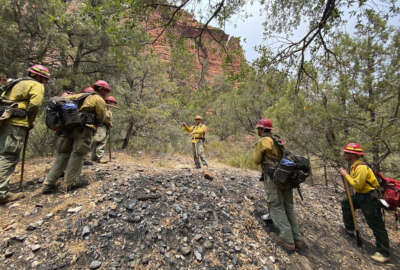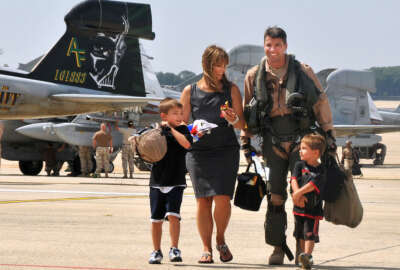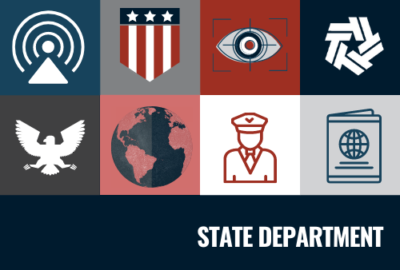
Firefighters get what they want in the new Defense Authorization law
Like much of the legislation enacted in the past couple of years, the National Defense Authorization Act has something for everybody. That includes the nation's...
Best listening experience is on Chrome, Firefox or Safari. Subscribe to Federal Drive’s daily audio interviews on Apple Podcasts or PodcastOne.
Like much of the legislation enacted in the past couple of years, the National Defense Authorization Act has something for everybody. That includes the nation’s federal and military firefighters. For more, the Federal Drive turned to the president of the International Association of Fire Fighters, Edward Kelly.
Interview transcript:
Tom Temin
Let’s just establish that the NDAA mainly concerned federal firefighters, military firefighters, but they are also represented by your union.Edward Kelly
Our International Association of Firefighters has 333,000 paid professional firefighters and EMTs and dispatchers and paramedics throughout the United States and Canada as far away as Guam and Guam and the Mariana Islands. So we have quite a swath of professional firefighters, but we do have 3,500 of our hard working very hard working work 72 hours a week, is that regular schedule federal firefighters to protect them primarily on military installations.Tom Temin
And let’s talk about what’s in that NDAA. And let me ask you about cancer presumption for federal firefighters diagnosed with cancers linked to that occupation. What’s that all about?Edward Kelly
Tom, that’s the most important issue that the NDAA address for firefighters 97% of firefighters in the United States and Canada have cancer coverage. If we get diagnosed with cancer, it’s presumed to be job related because of all of the exposures we endure over the course of a career. What the federal firefighters never had that protection, firefighters that worked on military installations protected our military and our civilians in the federal sector, when they were diagnosed with cancer. And of course, many of them, unfortunately, succumb to it. Their families were basically left unprotected financially, they got no help. And what this does is right a wrong, you know, Congress got it right. So now, God forbid, it happens. It’s the number one killer of firefighters is cancer. When our federal firefighters are now diagnosed with cancer, they’ll get the coverage that they need to protect themselves and their family from that job related incurred illness, you know, that that big, you know, obviously has a terrible impact on families.Tom Temin
It’s almost parallel to what Congress did for veterans in the burn pit situation.Edward Kelly
Correct. It’s very much in the same vein, and Tom, I happen to have the honor of serving in the United States military, our veterans, and those that serve the public deserve to be taken care of when our service comes with the sacrifice, of being diagnosed, ill, etc. I believe, society that we protect owes it to those of us to take those olds that make those sacrifices to protect us and our families. You know, when harm comes our way.Tom Temin
And when you think of federal firefighting, you think of the wildfires going on but then I think people sometimes overlook military firefighters and military operates some bases and camps and posts that are small cities, and there’s a firefighting there, isn’t there?Edward Kelly
Absolutely. I was an Air Force firefighter at Tyndall Air Force Base, down in Panama City, Florida and we had a very active base with three training squadrons at the time it was F-15s. Each one of which if we burnt up an F-15 would cost millions and millions and millions of dollars. So our primary mission as federal firefighters is to protect life. But also there’s so much very expensive property on our military installations that if we can stop a fire before it does major damage, it saves exponential amount of money. And if you look next door to Tyndall, we have Eglin Air Force Base. You mentioned a small city, Eglin Air Force Base is larger than the state of Rhode Island. I mean, high rise hospitals, a lot of hazards. You know, we have major military installations with very specific and dangerous hazards that our firefighters have to be specifically trained for, you know, one of the exposures that we endure in particular our federal firefighters is PFAS exposures. One of the tools that we use in firefighting is aqueous film forming foam particularly for our jet fuel. So a lot of our military installations that have flight that our flight lines we’ve been using AFFF. AFFF is laden with PFAS that PFAS is what we call it forever chemical very dangerous you see it now. A lot of the all of our federal military people I would hope at this point know what PFAS is all of us have been exposed to it. So another important thing that the NDAA did for us with PFAS is it forces the DoD when they do their research to share that research. So we know what not only we as firefighters, but our veterans and our families who were also exposed, what potential ramifications that exposure could cause our health and what we need to be tested for and screened for. So it’s very important. I mentioned that PFAS band foam. We also have that same PFAS infused into our PPE, personal protective equipment our bunker gear that you see us wearing that is loaded with PFAS as well. So another important aspect the NDAA is it forces the DoD to never purchase PFAS laden gear once an alternative becomes available, very important for us.Tom Temin
We are speaking with Edward Kelly. He is president of the International Association of Firefighters. And just a quick question on the PFAS alternative foams are pretty much in development now. Correct. So mainly what this does is keep it out of the gear, because I’m pretty sure they do have alternative foams that the required by now correct.Edward Kelly
They do. In fact, other countries have banned PFAS laden fuel years ago. So we’re actually catching up to some of the other, you know, modern countries around the world that have made those advances already.Tom Temin
Now, is there gear available that does not have PFAS?Edward Kelly
Not at this time. It’s an interesting dilemma that we find ourselves in the governing standards body, the NFPA that defines what a PPE ensemble needs to incorporate actually has in the esteem that requirements that would call for the infusion of PFAS into the gear, we have actually been pushing the NFPA fighting the NFPA, we actually filed an amendment emergency amendment to change that out which was actually denied by the NFPA Committee. So we’re pushing the NFPA committee to change that standard. So we can produce and manufacture PFAS free gear. For our members. We’re confident that in this day and age, we can absolutely create a PPE ensamble that’s not going to poison us.Tom Temin
Right and will also protect you from heat and smoke and fire.Edward Kelly
Correct. We certainly have the wherewithal at this stage of the game to be able to come up with a safer alternative.Tom Temin
And the NDAA also had something to say about minimum staffingEdward Kelly
We bring to an emergency whether it’s a fire, an accident, is people trained qualified firefighters, paramedics, the most important thing we bring it’s not water, it’s not ladders, it’s people and what minimum staffing does in the NDAA is brings our DoD firefighters staffing levels, up to what the NFPA standard calls for what a lot of municipalities have, which is four firefighters on a pumper an engine and three firefighters on a crash truck and aircraft rescue truck. So that brings us up to minimum staffing levels, which is critical when we have an emergency. So that that’s a great benefit not only to us firefighters to work safer, but also it enhances our ability to protect the civilians that was that we took an oath to do just that.Tom Temin
Let me ask you this the life of a firefighter in the military, is it similar to that in the civilian life that is to say you have a shift, and you spend that in the firehouse in ready state?Edward Kelly
I would say federal firefighters have it really much worse than civilian firefighters. The average firefighter works between 42 to a 56 hour work week, federal firefighters have to work a 72 hour work week minimum. So you know, if you think about it’s going to be 2023 here in about a week, how many other sectors in the workforce in a call a first world country have a average work week of 72 hours, that’s 72 hours away from home. That’s before, you know we have general staffing crisis is across the fire service. That’s before you get forced and overtime or taken overtime. We have Kelly days in some place where they get cancelled. So all of that adds up to working in some cases over 100 hours a week. That’s that’s significant. And that caused a lot of health challenges. And you can imagine, you know, the struggles trying to raise a family when someone has to be away from home 72 to 100 hours a week.Tom Temin
And when they’re not actually fighting a fire. They don’t also just sit around reading books and cooking spaghetti either, do they?Edward Kelly
No, no, I we do like to cook spaghetti. But there’s also significant training involved in maintaining hazardous materials capabilities, maintain your technical rescue capabilities, ensuring that you’re up to speed and your medical certifications that there is a lot of work goes into training and making sure that we’re prepared for all of the unique hazards that we face protecting military installations.Tom Temin
And do we have any statistics about how many fires occur in the military installations throughout the year? How big a problem is this?Edward Kelly
Oh, we have we’ve had significant fires. You think about some of the ship fires that we had. We had one up in San Diego a couple of years ago. That was very simple burn for a couple of days. We also had a submarine fire up in New Hampshire in Portsmouth Naval Base. When we have fires like that. Sometimes we can do hundreds of millions of dollars in damage. And it compromises quite frankly, our national security. So it’s less the number of occurrences of serious fires that we have on military installations. It’s the fact that one fire can do an incredible amount of not only financial but national security compromising damage that we have to be prepared, trained, staffed, equipped and ready to mitigate in a moment’s notice. That’s the real challenge that we can have significant problems with unique life safety hazards with a tremendous financial impact. That’s why we need to make sure we train staffed and properly equipped on on military installations.Tom Temin
And anything else in the NDAA we need to know about?Edward Kelly
There was also a piece that allowed more behavioral health services to become available through the NDAA. They look at issues like we’ve had, say the Boston Marathon bombing that was not a federally declared disaster. What the NDAA does through this legislation is allows FEMA, the Federal Emergency Management Agency to provide some behavioral health services to those impacted by disasters that aren’t quite the level of a national disaster. So that’s very important. I’d also mention that they’re building some new firehouse, including in my old base Tyndall Air Force Base, in Fort Carson, Colorado, in Fort Bliss, Texas, what we’re learning is that by designing a more modern firehouse, we can compartmentalize the exposures that we bring back into the firehouse and that we basically live with it. And by compartmentalizing those exposures, it reduces the health impact that it has on firefighters. So those new fire houses, they’re not only necessary, because they’re very old, they also will have a positive health impact in the long term. Also important another thing that we fought for and supported and ask President Biden to personally intervene on, is the Red Hill fuel facility out in Hawaii. Our Hawaii firefighters as you can imagine, we’re up in arms and concerned about the jet fuel leaking into the drinking water. And I’m proud to say and happy to see the President Biden stepped up and the NDAA directs the DoD to de-fuel that facility and address those environmental issues that are out there in Hawaii, so we applaud him for that.
Copyright © 2025 Federal News Network. All rights reserved. This website is not intended for users located within the European Economic Area.
Tom Temin is host of the Federal Drive and has been providing insight on federal technology and management issues for more than 30 years.
Follow @tteminWFED
Related Stories






